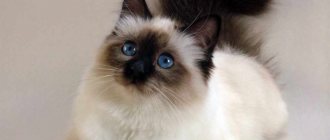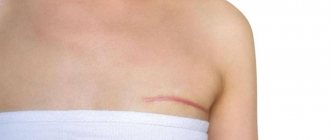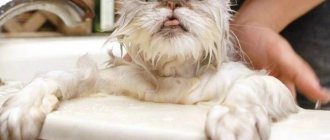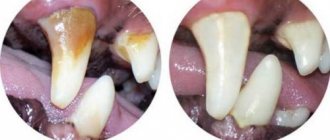Every pet owner will sooner or later face the problem of tattered furniture and wallpaper. The question will arise: can a cat’s claws be trimmed, and is such an ambiguous procedure dangerous for the pet? In the wild, animals wear down their claws naturally, climbing trees and running on hard surfaces. Pets often do not have such opportunities. So they have to sharpen their scratches on what they see in the apartment. And there is no escape from this; instinct is inherent in the animal by nature itself. It is possible to cope with such a problem, you just need to be well prepared.
Why do you need to trim your nails?
First of all, this is the cat's main weapon for protection and a hunting tool.
On the streets of the city, the animal has many enemies, from whom only teeth and sharp claws can help. Also, the cat’s natural arsenal allows him to win the lady of his heart or climb a tall tree in case of danger. Rodents are destined to become a hearty meal for lucky hunters with sharpened nails. However, pet owners ask the question: why trim a cat’s claws if it doesn’t go outside? And how to cut it correctly so as not to harm the animal? This treatment is needed, first of all, to prevent diseases and prevent abnormal growth of claws. Sharp, long claws can cause damage if they fall from a height. Another reason is to preserve the interior decor of the room (furniture, walls, interior items) and clothing. The process of scratching household utensils leads to scandals that negatively affect the mental state of both the cat and the residents of the apartment.
There are good reasons when to apply a haircut:
- Keeping a cat at home. The animal is kept indoors only and does not go outside on its own. Because it is impossible to sharpen its claws in nature, it is forced to scratch furniture and walls, ignoring the scratching post.
- Having small children in the apartment. Sharp claws pose a danger to infants and preschoolers. In the game, an animal can injure a child and cause an infection.
- In case of illness or low mobility. An unhealthy cat cannot carry out hygiene activities on its own. Also, when a pet has an infantile temperament, is old or is overweight, then human help is needed.
- For preventive purposes, for aesthetics. Removing the upper part of the claws is important to prevent the occurrence of purulent foci of inflammation. The procedure is mandatory when the cat participates in exhibitions, for safe bathing.
It should be remembered that trimming nails causes deep stress in the animal. Therefore, the owner must analyze all the pros and cons. The need for the procedure must outweigh the risk of problems.
What is the operation
The main thing that every cat owner should know is that declawing is the removal of the cat's first phalanges. Essentially, this is the amputation of half a finger along with the claw. The operation is performed under general anesthesia, but upon awakening the animal will experience excruciating pain. The suffering will drag on for a month, then there will be a period of long rehabilitation with an unpredictable outcome.
What do you do at 109 years old? Zhenya Tsetskhladze takes care of a 2-year-old boy
Not ready for a family: what is known about the star of the t/s “Solar Circle” Pyotr Rykov
Robot disinfector and other new products for the post-pandemic world at the exhibition
Declawing is a mutilating operation. The cat will never walk the same way again. Often, due to stress and lack of understanding of what is happening to it, the cat refuses to move at all. It is especially difficult if the operation is performed on all four limbs, but most often the claws are removed only on the front paws.
How often does it need to be trimmed?
It is impossible to answer this unequivocally. It all depends on the lifestyle and individual characteristics of the pet. The period between haircuts can be up to 2 weeks or once a month. Cats with black color should carry out the procedure very carefully. The minimum length should be removed, since the pulp is not marked at all. It is recommended to carry out treatment no more than once a week. Long-haired cats and sphinxes need to do this more often; they are susceptible to rapid growth and keratinization of their claws. People often ask: “The cat’s claws are crumbling and peeling—what should I do?” Of course, get a haircut!
Attention! A cat's claws need to be trimmed correctly. In the middle there is a pulp with a blood vessel, where the color is pink. If you touch this area, the cat will be in great pain and will bleed. If this happens, you need to quickly treat the wound site with any antiseptic, for example, hydrogen peroxide, and stop the bleeding.
How many claws does a cat have on its hind and front paws?
Mammals have five-fingered limbs. The cat differs from other mammals in that it has 18 toes, each with one claw.
How many fingers does a cat have, so many nails?
The number of claws on the front and hind limbs is different. There are five fingers in front - ten claws. The hind ones have four fingers, which means eight claws.
Four fingers with claws are located in one row, and the fifth with a claw is slightly protruded to the side, which allows it not to touch the floor surface when walking. The fifth finger is vestigial.
How to prepare your cat for the procedure
It is advisable to choose a time when the pet is calm, well-fed, and in a good mood.
Before carrying out the procedure, it is necessary to prepare the cat: caress and massage its paws. Try not to worry or make any sudden movements. Animals immediately smell a catch and try to immediately run away. Each pet has its own character and this must be taken into account: adult cats are more nervous and suspicious, but it is much easier to negotiate with young kittens. First you need to sit comfortably, put the animal on your lap or on the table. It is advisable to ask someone else for help in order to fix it better. Perhaps the pet will begin to bite, scratch his hands, and try to escape. Just in case, the assistant needs to wear thick gloves or swaddle the cat in thick cloth. The procedure can be divided into stages, processing is carried out gradually. There is a nuance: before cutting, you need to remove excess hair between the pads on the paws. It is advisable to do without buzzing instruments so as not to frighten your pet. Then the idea will have to be left until next time.
Postoperative period. Caring for a cat after declawing surgery
The rehabilitation period can vary in length. It depends on how your pet tolerated the procedure itself, how well it was done, and how you cared for him after the operation.
For the first few days or weeks, the cat will not be able to walk normally, and he may experience pain in the joints and back. It is important that he does not untie the dressing and disturb the wound. It is worth putting a special cervical collar (“Elizabethan”) on your pet to keep him from these actions. Seams need to be treated every day.
Due to the fact that the paws have become overly sensitive, the cat may stop going to the usual toilet. It is worth changing the filler to a softer option. You should not let your pet go outside, as there is a high risk of infection, and the animal simply will not be able to run away if necessary and climb trees.
How to trim a cat's claws
To trim your cat's claws yourself, you should visit a pet store or veterinary pharmacy. There is a wide range of special tools available. These are ultra-modern devices and run on batteries or mains power.
Regular scissors.
Every home has a tool; it is allowed for trimming soft nails of young animals. The main condition is extreme caution so as not to cut off the excess part of the claw and not touch a blood vessel.
Claw clippers.
There is no need to experiment with ordinary nail clippers; here you need: a special pruner, reinforced nippers, nail clippers.
Guillotine trimmer.
A good device for removing the tips of thick, strong nails. Makes the cut as rounded as possible. The only drawback is the noise, which scares the cat.
Grinder.
The device is convenient and easy to use. The working element is a sharpening stone with an abrasive coating, which allows you to grind the surface painlessly. Polishing takes place gradually.
File.
It is better to purchase a tool with round ends; it will be needed to remove irregularities after working with nail clippers.
The devices must be well sharpened; it is recommended to give preference to stainless steel tools. The handles are made of non-slip material so as not to accidentally injure the animal.
Consequences of the operation
The worst thing is incomplete removal of phalanges in cats. In this situation, the tissue will try to recover. Modified crooked claws will begin to grow from remote areas, and they often grow inside the paw. In this case, it will be excruciatingly painful for the cat to walk, and the operation will have to be repeated.
GTA 5 for PS5 and Xbox will now run on the RDR2 engine
Hybrid aircraft engines will reduce nitrogen oxide emissions by 95%
Nissan Z Proto Unveils 400Z Twin-Turbo V6
But even with complete removal, the cat will remain crippled at the end of the operation. She will be afraid to walk, stop using the litter box (she will not be able to rummage through it due to pain and discomfort), and will be in constant stress. The animal will constantly feel that something is wrong with her. After all, everything connected with claws is deep in their blood. The psychological state of the pet will never be the same.
Do all cats need to have their nails trimmed?
You should get a manicure if your cat is an indoor cat and does not go outside. When your pet walks in the fresh air or visits a dacha, you cannot cut its nails. A free-range animal wears down the tips of its claws while climbing trees or running on asphalt. Cats need them for defense against enemies; without them the animal is defenseless. Veterinarians do not encourage this procedure, especially if the pet is healthy. However, in some situations you need to do this:
- When an animal behaves aggressively, it is very dangerous for small children.
- Scratches walls, furniture, doors in the apartment.
- Clings to floor coverings and soft blankets, risking injury.
Under no circumstances should you trim the claws of a pregnant cat, as this can cause premature birth. If a small kitten has settled in the house, it is advisable to accustom it to the procedure from an early age. The baby hisses and bites - then you should postpone the lesson and repeat it later. The need for nail trimming may depend on the breed, for example, Sphynxes and Persians sometimes have specific problems.
In Persian cats, keratinized growths often grow and peel off. This occurs due to a deficiency of vitamins B and D in the body. Hair mats (mats) also form between the fingers, which need to be cut. The Scottish Fold breed often suffers from claw abnormalities, which needs to be carefully monitored and trimmed in a timely manner. If you don’t do this, your pet may get caught and pull out the claw completely. Also, during play, a cat can injure a person or other animal.
Nothing can replace the love of their owner for our pets. They trust us with their health and life. Let's make the stay of furry pets near us safe and calm. After all, our life becomes much more interesting with cats.
The norm for the number of claws and deviations from it
How many toes mean how many claws a cat has on its hind and front paws?
Eighteen claws is the norm, which is confirmed by felinological organizations of the international level.
A mutation at the genetic level leads to the formation of additional fingers - polydactyly, and, accordingly, additional claws.
This anomaly does not affect the health of cats in any way. Additional claws can be located on different sides of the limb, and their functionality depends on this.











